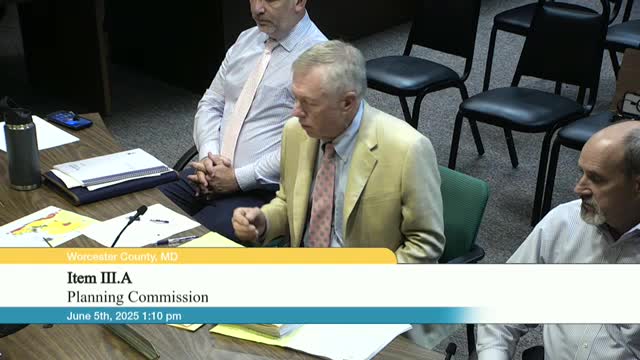Maryland court reinstates commercial zoning for Atlantic General Hospital's medical campus
June 05, 2025 | Worcester County, Maryland
This article was created by AI summarizing key points discussed. AI makes mistakes, so for full details and context, please refer to the video of the full meeting. Please report any errors so we can fix them. Report an error »

On June 5, 2025, the Worcester Planning Commission convened to discuss significant developments surrounding a proposed medical campus linked to Atlantic General Hospital. The meeting highlighted the complex history of zoning changes and legal battles that have shaped the project, which aims to address growing healthcare demands in the region.
The discussion began with a recap of the legislative framework that allowed for the establishment of a casino near the intersection of Route 589 and Route 50, which set the stage for subsequent commercial zoning approvals. The county commissioners granted commercial zoning in 2012, but this decision faced challenges from local residents, leading to a circuit court ruling that reinstated agricultural zoning. However, an appeal to the Court of Special Appeals ultimately reversed this decision, reinstating the commercial zoning necessary for the hospital's expansion plans.
The proposed medical campus was initially envisioned as a large facility featuring 100,000 square feet of space, including four operating rooms and various outpatient services. This ambitious plan was driven by the hospital's need to expand due to increasing patient volumes and limitations imposed by the Global Revenue cap, which restricted hospital earnings based on previous years' revenues. However, the landscape shifted dramatically with the onset of the COVID-19 pandemic and subsequent changes in state regulations, leading to the abandonment of the original plan for a larger facility.
In light of these changes, the hospital scaled back its project, ultimately constructing a smaller medical campus that still meets essential community needs but lacks the extensive services initially proposed. The revised facility now accommodates necessary office space and outpatient services, albeit at a reduced capacity.
The meeting also touched on the competitive landscape of healthcare facilities in the area, with other providers, such as Bridal Health, advancing their projects while Atlantic General Hospital adjusted its plans. This situation underscores the dynamic nature of healthcare development in Worcester County, where community needs and regulatory environments continually evolve.
As the Planning Commission concluded its discussions, the implications of these developments were clear: the future of healthcare infrastructure in Worcester County hinges on navigating complex zoning laws, community concerns, and the ever-changing landscape of healthcare regulations. The commission's ongoing efforts will be crucial in ensuring that the region's healthcare facilities can adapt to meet the needs of its residents effectively.
The discussion began with a recap of the legislative framework that allowed for the establishment of a casino near the intersection of Route 589 and Route 50, which set the stage for subsequent commercial zoning approvals. The county commissioners granted commercial zoning in 2012, but this decision faced challenges from local residents, leading to a circuit court ruling that reinstated agricultural zoning. However, an appeal to the Court of Special Appeals ultimately reversed this decision, reinstating the commercial zoning necessary for the hospital's expansion plans.
The proposed medical campus was initially envisioned as a large facility featuring 100,000 square feet of space, including four operating rooms and various outpatient services. This ambitious plan was driven by the hospital's need to expand due to increasing patient volumes and limitations imposed by the Global Revenue cap, which restricted hospital earnings based on previous years' revenues. However, the landscape shifted dramatically with the onset of the COVID-19 pandemic and subsequent changes in state regulations, leading to the abandonment of the original plan for a larger facility.
In light of these changes, the hospital scaled back its project, ultimately constructing a smaller medical campus that still meets essential community needs but lacks the extensive services initially proposed. The revised facility now accommodates necessary office space and outpatient services, albeit at a reduced capacity.
The meeting also touched on the competitive landscape of healthcare facilities in the area, with other providers, such as Bridal Health, advancing their projects while Atlantic General Hospital adjusted its plans. This situation underscores the dynamic nature of healthcare development in Worcester County, where community needs and regulatory environments continually evolve.
As the Planning Commission concluded its discussions, the implications of these developments were clear: the future of healthcare infrastructure in Worcester County hinges on navigating complex zoning laws, community concerns, and the ever-changing landscape of healthcare regulations. The commission's ongoing efforts will be crucial in ensuring that the region's healthcare facilities can adapt to meet the needs of its residents effectively.
View full meeting
This article is based on a recent meeting—watch the full video and explore the complete transcript for deeper insights into the discussion.
View full meeting
